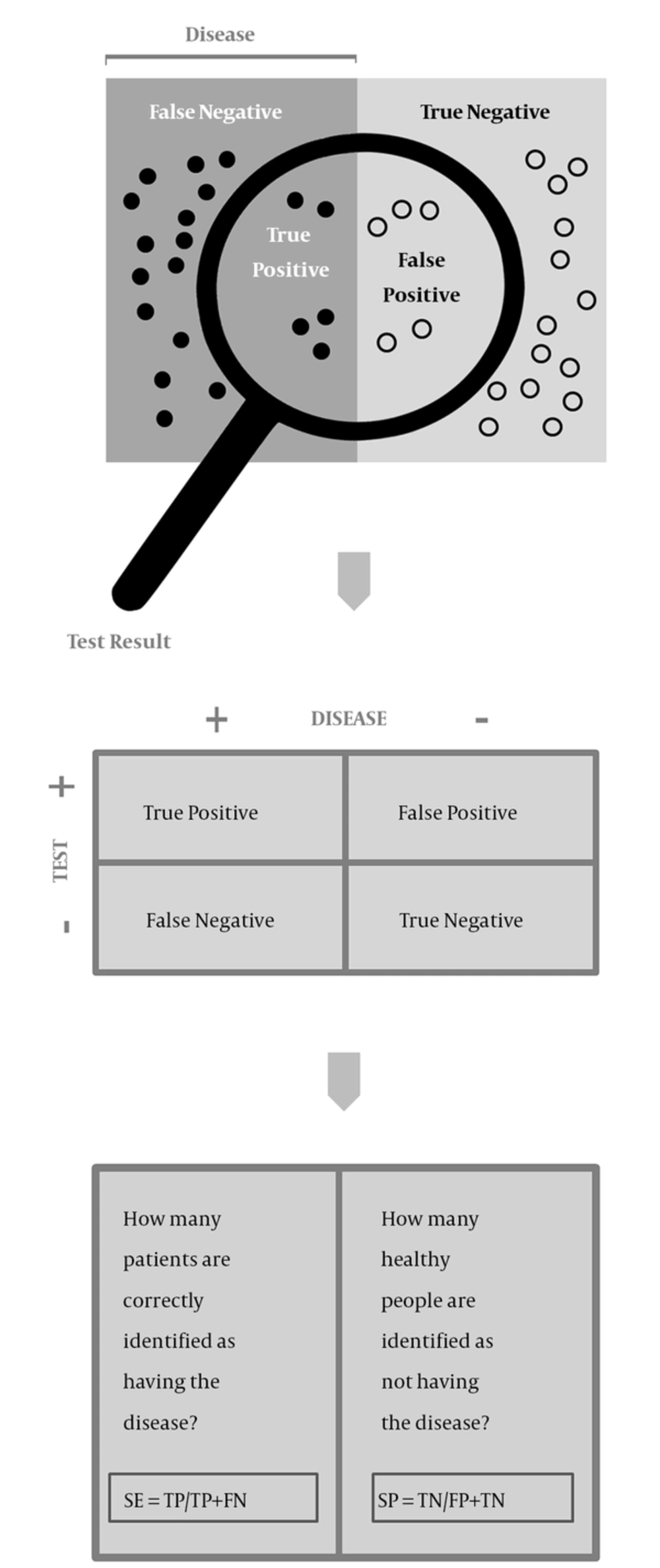Dear Editor,
Diagnostic tests, which accurately diagnose the disease, play an essential role in the decision of clinicians regarding the type of treatment. Nevertheless, it is possible to evaluate the attribution of diagnostic tests, and choose the best possible one based on the results; to describe a test, sensitivity, specificity, and accuracy are extensively used.
The most understandable diagnostic test is one that can classify patients based on the manifested symptom (reported by the patient) or sign (discovered by the physician). Figure 1 shows the association of the test results and the disease. How good is the test at diagnosis of actual disease?
To evaluate the frequency of patients with negative and positive test results is an approach for accurate diagnosis. The presence or absence of a condition is shown with the terms positive and negative. The proportions of true positives and true negatives that are correctly diagnosed have confusingly similar names. The SE or true positive rate is the ability of a test to detect a true positive (Sensitivity = True Positive / True Positive + False Negative). The specificity or actual negative rate is the ratio of actual negatives accurately diagnosed based on the test (Specificity = True Negative / False Positive + True Negative) (1). The sensitivity and specificity usually come in ratios; therefore, confidence interval values can be calculated using the standard methods of ratios (2). The sensitivity and specificity are measured to assess the diagnostic test accuracy.
The accuracy of a test correctly differentiates patients and healthy cases. To evaluate the accuracy of a test, actual positive and actual negative ratio in all the cases should be calculated (Accuracy = True Positive + True Negative / True Positive + True Negative + False Positive + False Negative). A test is basically used in order to make a diagnosis; hence, the probability that the test can correctly diagnose a disease should be well understood. The sensitivity and specificity does not provide such information.
Data obtained from the test results can be replaced with predictive values. Positive predictive value or precision is the probability of having the disease in patients with positive test results (Positive Predictive Value = True Positive / True Positive + False Positive), whereas negative predictive value is the probability of accurate diagnosis in negative test results (Negative Predictive Value = True Negative / True Negative + False Negative). The sensitivity and specificity are characteristics of the test, and have no contribution to the prevalence of disease in the population, while predictive values depend on the disease prevalence in the population. If the test is performed in a high prevalence setting, the actual positive parents are accurately diagnosed compared with the tests performed in a low prevalence population. If the disease has a very low prevalence, the positive predictive value cannot be close to one even if both the sensitivity and specificity are high. Thus, many positive test results are false positives (3). Generally, physicians have a presumption about the health status of the patient based on the prevalence of the disease, patient’s characteristics, and symptoms and signs, which can affect the final decision of the physician. In other words, the prevalence is probability of the disease before performing the test, known as the prior probability of the disease. Also, the posterior probabilities are the revised values for positive or negative tests, known as the positive predictive value and negative predictive value (3). The accuracy of a test can be evaluated by differences between the prior and posterior probabilities. To assess the value of a diagnostic test, the likelihood ratios (+ and -) are used for evidence-based medicine, and for all the diagnostic tests, the probability of results can be compared if the patient is accurately diagnosed. The likelihood ratio is the ratio of these probabilities (Likelihood Ratio = Sensitivity / (1 - Specificity)) (3). If the data related to a test are inserted in a 2 × 2 contingency table (Figure 1), the Fisher’s exact test of many statistical software packages may be used to calculate sensitivity, specificity, positive predictive value, negative predictive value, and likelihood ratio.
In conclusion, this educational review simply describes the fact that the ability to make a diagnosis depends both on the discriminatory value of the test and on the prevalence of the disease in the population.

